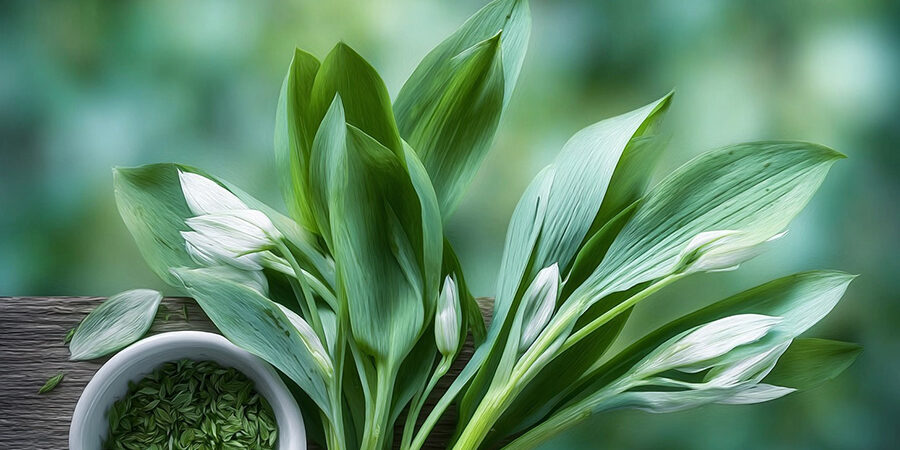With the support of our stable Hungarian producer base, this vegetable is always available in high quality in our wholesale assortment – ask us for an offer!
Allium ursinum, also known as ramsons or bear’s garlic, is a well-known and popular wild plant throughout Europe and one of the first harbingers of spring. It is said to derive its name from the fact that brown bears like to eat it when they wake up from hibernation to cleanse their bodies. Its strong garlic-scented leaves are not only succulent but also beneficial to health.
Its health benefits include improving digestion, strengthening the immune system and lowering blood pressure. It can also be a spring fatigue remedy due to its high vitamin C, iron and manganese content. It is also considered to be a natural antibiotic because of its antibacterial and anti-inflammatory properties.
Historically, bear’s garlic has been used as a medicinal herb since the Middle Ages. It was collected in forests, streamsides and groves all over Europe. Nowadays it is not only collected in the wild but also cultivated in small quantities. It is particularly popular in Central and Eastern Europe, including Hungary.
Specificities of the production of ramsons
The main season of the ramsons is early spring, from March to the end of April. This plant grows naturally in shady, moist deciduous forests. It can also be grown in the open, but intensive greenhouse cultivation is not common, as the plant is tied to its natural environment and has difficulty tolerating a dry, hot climate.
It is most abundant in Germany, Austria, Poland and Hungary. In Hungary, it is mainly collected in the Transdanubian region and in the North Central Highlands.
You can usually find fresh ramsons on the shelves from mid-March to the end of April. Products of Hungarian origin appear in early April, while imported products, such as Austrian or Polish goods, may appear in shops as early as the beginning of March. After the end of the season, it is rarely available fresh.
How to choose good quality ramsons?
- Pay attention to the colour of the leaves: look for a bright, dark green shade.
- Healthy leaves are firm, flexible, not flabby or mottled.
- Avoid yellowing, withered or wet leaves.
- Bear’s garlics are picked fresh, so their intense garlic smell can also indicate freshness.
How to use ramsons in the kitchen?
Bear’s garlic is extremely versatile. It has a taste reminiscent of garlic, but with a milder, softer character. It retains its flavours best when used fresh. Cooking or frying reduces its intensity but retains its flavour.
- It goes well with cream soups, such as potato or broccoli cream soup.
- Chopped up, it can be mixed with cottage cheese, butter, cream cheese and dips.
- You can mix it into pasta, risotto, egg dishes, omelettes.
- You can also make pesto with olive oil, walnuts or almonds.
- Bear’s garlic scones and bread are also a popular spring delicacy.
How to store ramsons?
Unfortunately, ramsons have a short shelf life and lose their freshness quickly. It is best to process the day of purchase or the next day. It is best stored in the refrigerator, wrapped in a damp paper towel or tea towel in a sealable container for 2-3 days.
If you want to store for the longer term, you can:
- chopped, mixed with olive oil, can be frozen (for example in an ice cube tray).
- stored as pesto, it can be used for months.
- drying is not recommended, as it loses its characteristic flavour.
Interesting facts about bear’s onion
- Its Latin name, “Allium ursinum”, is also associated with bears – “ursinum” meaning “of bears”.
- The leaves of bear’s garlic can easily be mistaken for the poisonous lily of the valley or autumn chickweed – always rub the leaf when picking: the smell of garlic will help you identify it!
- It is protected in many countries, and its collection is regulated, for example in Hungary, where it can be collected in limited quantities from its natural habitat.
- In recent years it has also been referred to as a “superfood”, especially in its raw form.
Tips for using ramsons in the kitchen
- Use it fresh, not overcooked: it retains its intense flavour and nutrients.
- It pairs well with potatoes, eggs, cream sauces and sour cheeses (e.g. feta, goat cheese).
- To make bear’s onion butter, mix chopped ramsons in soft butter and keep in the fridge.
- You can also make ramsons marinades for meat, especially chicken or fish.
- Chopped into fresh salads, it gives a special, piquant flavour.
Bear’s garlic stands out not only for its special taste but also for its positive effects on health. In spring, it is worth taking advantage of its short season and incorporating it into a fresh, green diet.


